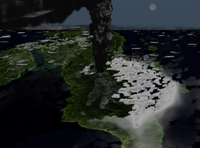
Photo from wikipedia
Quartz is a common phase in high-silica igneous rocks and is resistant to post-eruptive alteration, thus offering a reliable record of magmatic processes in silicic magma systems. Here we employ… Click to show full abstract
Quartz is a common phase in high-silica igneous rocks and is resistant to post-eruptive alteration, thus offering a reliable record of magmatic processes in silicic magma systems. Here we employ the 75 ka Toba super-eruption as a case study to show that quartz can resolve late-stage temporal changes in magmatic δ18O values. Overall, Toba quartz crystals exhibit comparatively high δ18O values, up to 10.2‰, due to magma residence within, and assimilation of, local granite basement. However, some 40% of the analysed quartz crystals display a decrease in δ18O values in outermost growth zones compared to their cores, with values as low as 6.7‰ (maximum ∆core−rim = 1.8‰). These lower values are consistent with the limited zircon record available for Toba, and the crystallisation history of Toba quartz traces an influx of a low-δ18O component into the magma reservoir just prior to eruption. Here we argue that this late-stage low-δ18O component is derived from hydrothermally-altered roof material. Our study demonstrates that quartz isotope stratigraphy can resolve magmatic events that may remain undetected by whole-rock or zircon isotope studies, and that assimilation of altered roof material may represent a viable eruption trigger in large Toba-style magmatic systems.
Journal Title: Scientific Reports
Year Published: 2017
Link to full text (if available)
Share on Social Media: Sign Up to like & get
recommendations!